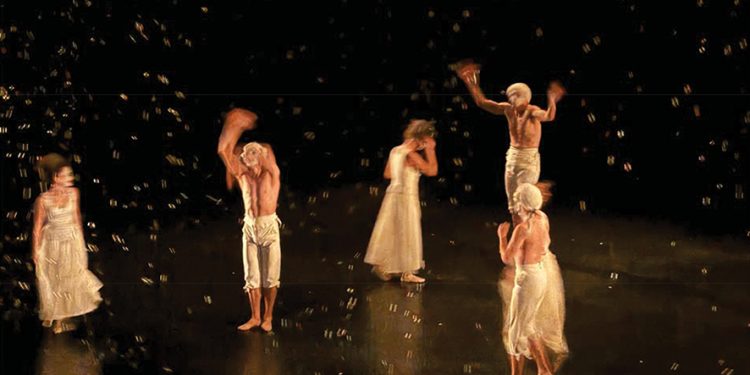On October 11-13, the Tbilisi Opera Ballet Theater staged three masterworks by the legendary choreographer Jirí Kylián: Petite Mort, Falling Angels, and Sechs Tänze. This celebrated revival, guided by the hands of artistic director Nina Ananiashvili and conductor Levan Jagaev, provided a powerful meditation on the intricacies of human existence. Each ballet, while vastly different in tone and theme, was unified by Kylián’s signature fusion of emotional depth, discipline, and playfulness.
Petite Mort: Beauty, Power, and the Proximity of Death
Kylián’s Petite Mort, set to the slow movements of Mozart’s Piano Concerto No. 23 and No. 21, explores the delicate intersection between life and death, pleasure and finality. With David Aladashvili’s exquisite live performance on piano, the dancers seemed to evoke both the ecstasy and fragility of human existence, echoing Kylián’s statement that life’s greatest pleasures are often tinged with the presence of mortality.
The choreography, featuring duets framed by the poignant metaphor of the “petite mort,” was a dance of subtle tensions. Fencers swayed their swords as symbols of masculine power, yet it was the vulnerability of their movements that caught the eye. Each torso-like motion, paired with Mozart’s somber adagio, felt stripped of embellishment, leaving behind raw, visceral images of human bodies grappling with their impermanence. The ballet itself, a conversation between life and death, evoked a hypnotic stillness in the audience, as they bore witness to a dance where time stood suspended—contemplating the inevitable.
Falling Angels: The Delicate Balance of Discipline and Freedom
In Falling Angels, Kylián shifts the focus to the complexity of female existence within the strictures of art and society. Eight female dancers, never leaving the stage, performed against Steve Reich’s rhythmic Drumming, Part I. The minimalist score, pulsing and repetitive, formed the backdrop for a ballet that explored the tension between discipline and freedom.
Kylián’s choreography dissected the stage into geometric sections, highlighting both the interdependence and the individuality of the performers. The dancers seemed trapped within these structures, yet their subtle yearning to break free was palpable. The work, both a tribute to and critique of the pressures placed on female performers, moved seamlessly between moments of quiet vulnerability and bursts of contained rebellion.
The physicality of the dancers, coupled with the intense focus Reich’s music demands, was mesmerizing. It was clear that each movement was both carefully controlled and deeply felt, embodying Kylián’s signature blend of emotional expressiveness and formal rigor. The ballet left the audience with a sense of the constant push and pull between belonging and independence—an existential struggle that defines much of human experience, particularly for women navigating the world of performance.
Sechs Tänze: A Dance of Absurdity and Wit
The final piece of the evening, Sechs Tänze, offered a stark departure in tone. Yet beneath its surface playfulness lay a reflection on the absurdity of life—a theme that ran through all three works. Set to Mozart’s Six German Dances, KV 571, this ballet was a whirlwind of exuberance, wit, and physical comedy.
The dancers donned powdered wigs and 18th-century costumes, but these formalities quickly gave way to a sense of chaotic liberation. The piece was filled with bizarre juxtapositions, from whimsical group movements to sudden moments of stillness. The absurdity was contagious, and the audience responded with laughter—a rare reaction in the world of ballet, but one that felt perfectly in tune with Mozart’s playful score.
Despite its lighthearted veneer, Sechs Tänze delved into deeper questions about the nature of performance itself. Kylián seemed to suggest that, beneath the masks and costumes, life is nothing more than a farcical dance—a fleeting moment before we confront the mysteries beyond. It was a fitting conclusion to a program that consistently returned to the themes of life’s brevity, beauty, and madness.
A Creative Expansion for Tbilisi Opera Ballet
For the Tbilisi Opera Ballet, regularly performing Kylián’s works represents more than just an artistic challenge—it is an essential step toward expanding their range beyond classical ballet. Kylián’s choreography requires dancers to engage not only with technical precision, but also with deep emotional and intellectual material. His works balance minimalism with intense expression, and this blend of restraint and emotional release can help dancers develop a more nuanced understanding of movement. For a troupe traditionally grounded in classics like Giselle or Swan Lake, working with Kylián’s innovative style fosters a new approach to physicality and narrative.
Moreover, the frequent performance of Kylián’s works opens the door for the Georgian dance scene to be more prominently placed on the international contemporary ballet stage. As Georgian ballet continues to build its reputation globally, mastering Kylián’s repertoire signifies the versatility and artistic depth of the Tbilisi company. This continuous exposure to contemporary works will contribute to a richer, more diverse dance culture in Georgia, challenging audiences and performers alike to engage with ballet in new and profound ways.
Ballet as a Mirror to the Human Condition
Jirí Kylián’s works are not merely dances—they are explorations of the most essential elements of human life. Through movement, Kylián speaks of love, loss, discipline, rebellion, and the fleeting nature of existence. The Tbilisi audience on October 13th was treated to an evening of deeply intellectual yet emotionally resonant performances, where each ballet offered its own distinct reflection on life’s paradoxes. In the hands of Tbilisi Opera Ballet’s talented dancers and musicians, Kylián’s timeless themes were given a new vibrancy, leaving the audience with much to contemplate.
For those in search of art that challenges as much as it entertains, this evening of Jirí Kylián’s ballets was nothing short of sublime.
Review by Ivan Nechaev














